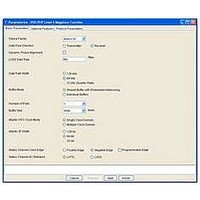IP-POSPHY4 Altera, IP-POSPHY4 Datasheet - Page 71

IP-POSPHY4
Manufacturer Part Number
IP-POSPHY4
Description
IP CORE - POS-PHY Level 4 SPI 4.2 Interface
Manufacturer
Altera
Type
MegaCorer
Datasheet
1.IP-POSPHY4.pdf
(144 pages)
Specifications of IP-POSPHY4
Software Application
IP CORE, Interface And Protocols, COMMUNICATION
Supported Families
Arria GX, Cyclone, HardCopy, Stratix
Core Architecture
FPGA
Core Sub-architecture
Arria, Cyclone, Stratix
Rohs Compliant
NA
Function
POS-PHY Level 4 Interface, Link-Layer/PHY Layer
License
Initial License
Lead Free Status / RoHS Status
na
Lead Free Status / RoHS Status
na
- Current page: 71 of 144
- Download datasheet (3Mb)
Chapter 4: Functional Description—Receiver
Latency Information
Latency Information
December 2010 Altera Corporation
The receiver MegaCore functions involve two kinds of latency: data latency and
status transmit latency.
Data latency is defined as the latency from the SPI-4.2 LVDS receive pins to the
internal Atlantic interface that is writing into the buffer(s). For the shared buffer with
embedded addressing mode, it does not include the time the data spends in the
buffer.
Status transmit latency is the number of clock cycles from when the status is provided
from the user logic or the Atlantic buffer until it is transmitted to the adjacent device,
assuming that the status channel is not disabled. It does not include the latency
involved in waiting for the previous transmit message to complete, or in waiting for
the status for other ports to be sent.
Figure 4–14 on page 4–31
receiver finish gives the receiver L
mode.
Figure 4–14. L
18
3
MAX
SPI-4.2
Individual Buffers Mode Overview
Receiver MegaCore Function
shows a picture of the L
CTL Word Processor)
Transmit
Receiver Processor
Status
(ALTLVDS, DPA,
Atlantic Buffer,
MAX
Data Latency
) for a receiver using the individual buffers
Generator
Status
& Port
Table
Status Latency
MAX
POS-PHY Level 4 MegaCore Function User Guide
FPGA
contributions (receiver start to
Processor
Buffer N
Buffer 1
Buffer 2
Status
4–31
Related parts for IP-POSPHY4
Image
Part Number
Description
Manufacturer
Datasheet
Request
R

Part Number:
Description:
IP CORE Renewal Of IP-POSPHY4
Manufacturer:
Altera
Datasheet:

Part Number:
Description:
IP Thermal Transfer Printer With Peel/Present Option
Manufacturer:
BRADY

Part Number:
Description:
CYCLONE II STARTER KIT EP2C20N
Manufacturer:
Altera
Datasheet:

Part Number:
Description:
CPLD, EP610 Family, ECMOS Process, 300 Gates, 16 Macro Cells, 16 Reg., 16 User I/Os, 5V Supply, 35 Speed Grade, 24DIP
Manufacturer:
Altera Corporation
Datasheet:

Part Number:
Description:
CPLD, EP610 Family, ECMOS Process, 300 Gates, 16 Macro Cells, 16 Reg., 16 User I/Os, 5V Supply, 15 Speed Grade, 24DIP
Manufacturer:
Altera Corporation
Datasheet:

Part Number:
Description:
Manufacturer:
Altera Corporation
Datasheet:

Part Number:
Description:
CPLD, EP610 Family, ECMOS Process, 300 Gates, 16 Macro Cells, 16 Reg., 16 User I/Os, 5V Supply, 30 Speed Grade, 24DIP
Manufacturer:
Altera Corporation
Datasheet:

Part Number:
Description:
High-performance, low-power erasable programmable logic devices with 8 macrocells, 10ns
Manufacturer:
Altera Corporation
Datasheet:

Part Number:
Description:
High-performance, low-power erasable programmable logic devices with 8 macrocells, 7ns
Manufacturer:
Altera Corporation
Datasheet:

Part Number:
Description:
Classic EPLD
Manufacturer:
Altera Corporation
Datasheet:

Part Number:
Description:
High-performance, low-power erasable programmable logic devices with 8 macrocells, 10ns
Manufacturer:
Altera Corporation
Datasheet:

Part Number:
Description:
Manufacturer:
Altera Corporation
Datasheet:

Part Number:
Description:
Manufacturer:
Altera Corporation
Datasheet:











